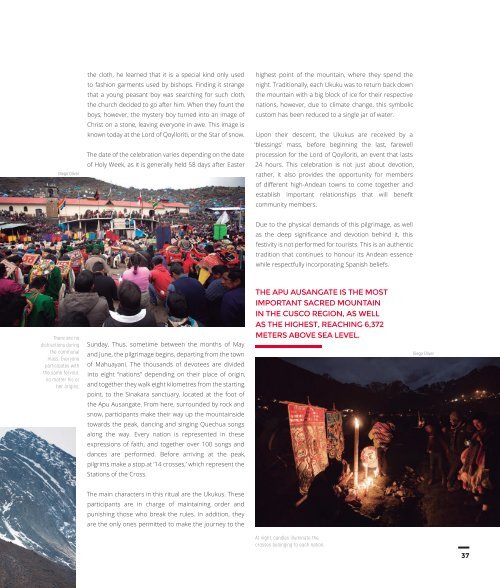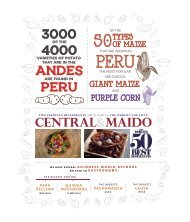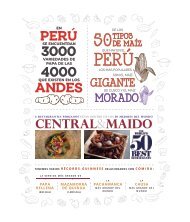UJ #17 - Traditional Peru
Create successful ePaper yourself
Turn your PDF publications into a flip-book with our unique Google optimized e-Paper software.
Diego Oliver<br />
the cloth, he learned that it is a special kind only used<br />
to fashion garments used by bishops. Finding it strange<br />
that a young peasant boy was searching for such cloth,<br />
the church decided to go after him. When they fount the<br />
boys, however, the mystery boy turned into an image of<br />
Christ on a stone, leaving everyone in awe. This image is<br />
known today at the Lord of Qoylloriti, or the Star of snow.<br />
The date of the celebration varies depending on the date<br />
of Holy Week, as it is generally held 58 days after Easter<br />
highest point of the mountain, where they spend the<br />
night. <strong>Traditional</strong>ly, each Ukuku was to return back down<br />
the mountain with a big block of ice for their respective<br />
nations, however, due to climate change, this symbolic<br />
custom has been reduced to a single jar of water.<br />
Upon their descent, the Ukukus are received by a<br />
‘blessings’ mass, before beginning the last, farewell<br />
procession for the Lord of Qoylloriti, an event that lasts<br />
24 hours. This celebration is not just about devotion,<br />
rather, it also provides the opportunity for members<br />
of different high-Andean towns to come together and<br />
establish important relationships that will benefit<br />
community members.<br />
Due to the physical demands of this pilgrimage, as well<br />
as the deep significance and devotion behind it, this<br />
festivity is not performed for tourists. This is an authentic<br />
tradition that continues to honour its Andean essence<br />
while respectfully incorporating Spanish beliefs.<br />
There are no<br />
distractions during<br />
the communal<br />
mass. Everyone<br />
participates with<br />
the same fervour,<br />
no matter his or<br />
her origins.<br />
Sunday. Thus, sometime between the months of May<br />
and June, the pilgrimage begins, departing from the town<br />
of Mahuayani. The thousands of devotees are divided<br />
into eight “nations” depending on their place of origin,<br />
and together they walk eight kilometres from the starting<br />
point, to the Sinakara sanctuary, located at the foot of<br />
the Apu Ausangate. From here, surrounded by rock and<br />
snow, participants make their way up the mountainside<br />
towards the peak, dancing and singing Quechua songs<br />
along the way. Every nation is represented in these<br />
expressions of faith, and together over 100 songs and<br />
dances are performed. Before arriving at the peak,<br />
pilgrims make a stop at ’14 crosses,’ which represent the<br />
Stations of the Cross.<br />
THE APU AUSANGATE IS THE MOST<br />
IMPORTANT SACRED MOUNTAIN<br />
IN THE CUSCO REGION, AS WELL<br />
AS THE HIGHEST, REACHING 6,372<br />
METERS ABOVE SEA LEVEL.<br />
Diego Oliver<br />
The main characters in this ritual are the Ukukus. These<br />
participants are in charge of maintaining order and<br />
punishing those who break the rules. In addition, they<br />
are the only ones permitted to make the journey to the<br />
At night, candles illuminate the<br />
crosses belonging to each nation.<br />
37

















